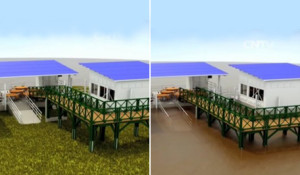Heavy rains have devastated Colombia. Now there’s a possible solution to one of the problems the rain created. And the people who dreamed up this solution might surprise you. Michelle Begue has our story from Sempegua, where the first Latin American floating school was inaugurated.

First Latin American Floating School Inaugurated
Heavy rains have devastated Colombia. Now there's a possible solution to one of the problems the rain created. And the people who dreamed up this solution might surprise you. Michelle Begue has our story from Sempegua, where the first Latin American floating school was inaugurated.Andres Uribe and Lina Catano wanted to create a building that could float when winter rains hit.
“[The school] is a bi-functional infrastructure. During the dry seasons, it is on the ground, and when it floods, it rises with the currents, so this is a permanent solution, not just temporary,” Uribe said.
It took years for Uribe and Catano to make their dream-project a reality. With the help of the United Nations Development Fund, Colombia’s National Disaster Risk Management, the European Union and the University Eafit of Medellin, the first floating school of Latin America was inaugurated in the Colombian town Sempegua.
During the rainy season, rivers and springs nearby overflow, causing floods in the town, but this structure has been built to float like a stationary boat, anchored to posts that are two meters high.
According to local officials, the small schoolhouse is part of a pilot program that has a minimum budget of US$200, 000. The maximum capacity of the three-room school three is 60 children, but for Catano, this is only the beginning.
“We want this to become a project on how to adapt to climate change, not just for Colombia but for Latin America. And when we talk about floatable housing solutions, we are not just imagining schools, but houses, health centers, sports centers, or commercial zones, so the town can continue to be productive,” he said.
The 400 families that will benefit from the program have no sewage system, and they only receive potable water for four hours each morning. Electricity is scarce during the two rainy seasons each year. The idea of being the center of this pilot program is an honor.
“With the new school, I feel good, because we don’t have to move like we used to when the floods come,” Sempegua student Jefferson Acuna Martinez said.
 CGTN America
CGTN America

